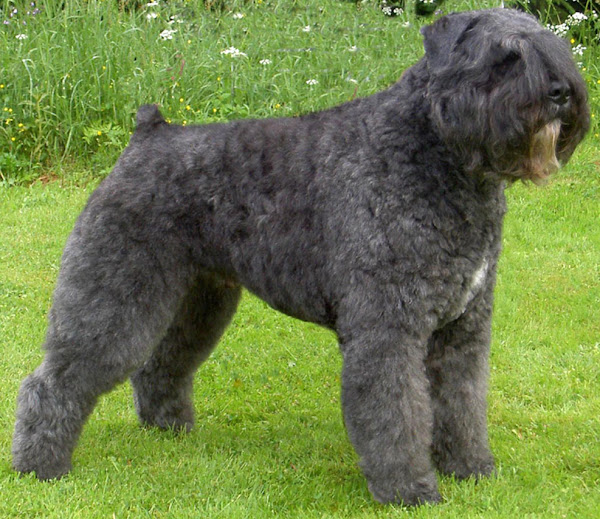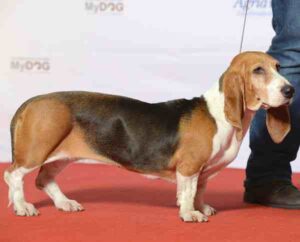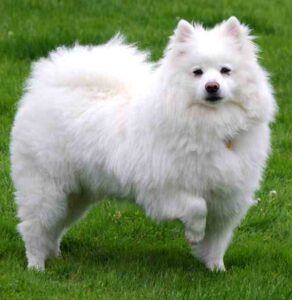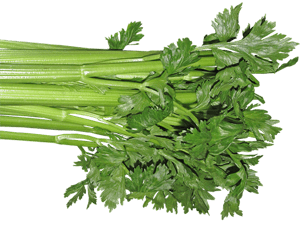The Bouvier des Flandres dog is a breed of herding dog, which were originally used for general farm work including cattle droving, cart pulling and sheep herding. Today, the breed is raised as guard dogs and police dogs, as well as being kept as pets.
The Bouvier des Flandres dog breed was originated in Flanders, Belgium. The French name of the breed means, literally ‘Cow Herder of Flanders‘, referring to the Flemish origin of the breed. Other names of the breed are Toucheur de Boeuf (cattle driver), Vlaamse Koehond (flemish cow dog), Vuilbaard (dirty beard) and Flanders Cattle Dog.
The monks at the Ter Duinen monastery were among the earliest known dog breeders in Flanders. The bouviers bred by them are recorded as having been bred from imports such as Irish wolfhounds and Scottish deerhounds with local farm dogs, until a breed considered to be the predecessor of the modern Bouvier des Flandres was obtained.
This became a working dog able to perform tirelessly, herding and guarding cattle and even pulling cargo carts, thanks to its strength and temperament, and to withstand the local weather conditions due to its thick coat. And after the invention of the automobile, practical use of the breed became antiquated (when cattle were more practically transported by trucks).
Up until the early twentieth Century, the Bouvier des Flandres dog breed was not completely defined, with 3 variants: Paret, Moerman or Roeselare, and Briard. Conflict between the proponents of these 3 variants held the breed’s development back.
In 1912 and 1913, several local kennel clubs recognized standards for Bouviers; however they usually had different standards for the Roeselare and other variants.
World War I nearly caused the breed to disappear, due to the devastation that came over its region of origin and the fact that the dogs were used for military purposes. However, World War II again endangered the breed’s existence. Due to these setbacks, progress was slowed, and it was not until 1965 that the Fédération Cynologique Internationale (FCI) breed standard, as agreed to by several minor kennel clubs, was adopted.[1]
Bouvier des Flandres Dog Characteristics
The Bouvier des Flandres dogs are powerfully built, compact, rough-coated dog of rugged appearance. The breed gives the impression of size and strength without clumsiness or heaviness.
The most notable feature of the Bouvier des Flandres dog is the impressive head which is accentuated by a heavy beard and mustache.
The practice of cropping both ears and tail are now mostly cosmetic, tails were originally docked to prevent injuries caused by herding and cart-pulling.
The practice of cosmetic docking is currently opposed by the American Veterinary Medical Association. And in the area of origin (Flanders, Belgium) cropping was made illegal in 2006.
The Bouvier des Flandres dogs have a thick double coat, which can be fawn, black, grey brindle or ‘pepper and salt’ in color.
Average body height of the mature dog is between 23 and 28 inches at the withers for the males, and between 22 and 27 inches for the females. Average live body weight of the mature dog is between 36 and 54 kg for the males, and between 27 and 36 kg for the females.

Temperament
The Bouvier des Flandres dogs are rational, gentle, loyal and protective by nature. They are also known for being intelligent, protective and strong willed. And not surprisingly, this herding dog likes to gather and protect it’s flock.
The breed is deeply attached and devoted to it’s family, and happiest when it’s a part of the action. It will get bored, if left alone for long periods and resort to annoying behaviors like barking, chasing, chewing as well as become very unhappy.
Like every dog, the Bouvier des Flandres dogs need early socialization. Exposure to many different people, sights, sounds and experiences is very important, especially when they are young. Socialization helps to ensure that your Bouvier des Flandres puppy grows up to be a well-rounded dog.
Lifespan
Average lifespan of the Bouvier des Flandres dog is between 10 and 12 years.
Feeding
How much a mature dog eats depends on it’s size, age, build, metabolism and activity level. Dogs are individuals, just like people, and they don’t all need the same amount of food.
The Bouvier des Flandres dogs are large in size and are moderately active, but require regular exercise. So, their diet should be formulated for a large-sized breed with high exercise needs. You can consult with a vet in your area for better recommendations.
Caring
Taking good care of the animals is very important for raising Bouvier des Flandres dogs. They are happy to lie around the house and enjoy the luxuries of companionship. They are not among the highly active dogs, but they do need regular exercise. They live comfortably in both city and country life.
You will need to take special care of the Bouvier des Flandres puppy. Like other large breeds, the Bouvier des Flandres dog grows very rapidly between the 4 and 7 months of age, making the breed susceptible to bone disorders.
Don’t let your puppy run and play on very hard surface such as pavement or pull a cart until it is fully grown and it’s joints are fully formed. Normal play on grass is fine, as is puppy agility play, with it’s one-inch jumps.
The Bouvier des Flandres dogs are suspicious of strangers and very protective of their family (these are considered good qualities for a herding dog). Socialization will prevent the dog from becoming overly shy or protective. You can take your puppy to many places that allow dogs, like pet supply stores to familiarize the dog to strangers and unfamiliar situations. Puppy training classes are highly recommended.
Health
The Bouvier des Flandres dogs are generally healthy. But like all other dog breeds, they are also prone to certain health conditions.
Their common health problems include hip or elbow dysplasia, cancer, cataracts, glaucoma, epilepsy, hypothyroidism etc. Always try to keep good contact with a vet in your area.
| Breed Name | Bouvier des Flandres |
| Other Names | Also known as Toucheur de Boeuf, Vlaamse Koehond, Vuilbaard and Flanders Cattle Dog |
| Breed Size | Large |
| Height | Between 23 and 28 inches at the withers for the males, and between 22 and 27 inches for the females |
| Weight | Between 36 and 54 kg for the males, and between 27 and 36 kg for the females |
| Good as pets | Yes |
| Climate Tolerance | All climates |
| Color | Fawn, brindle, black, grey or blonde |
| Lifespan | Between 10 and 12 years |
| Good for children | Yes |
| Rarity | Common |
| Country of Origin | Belgium |






